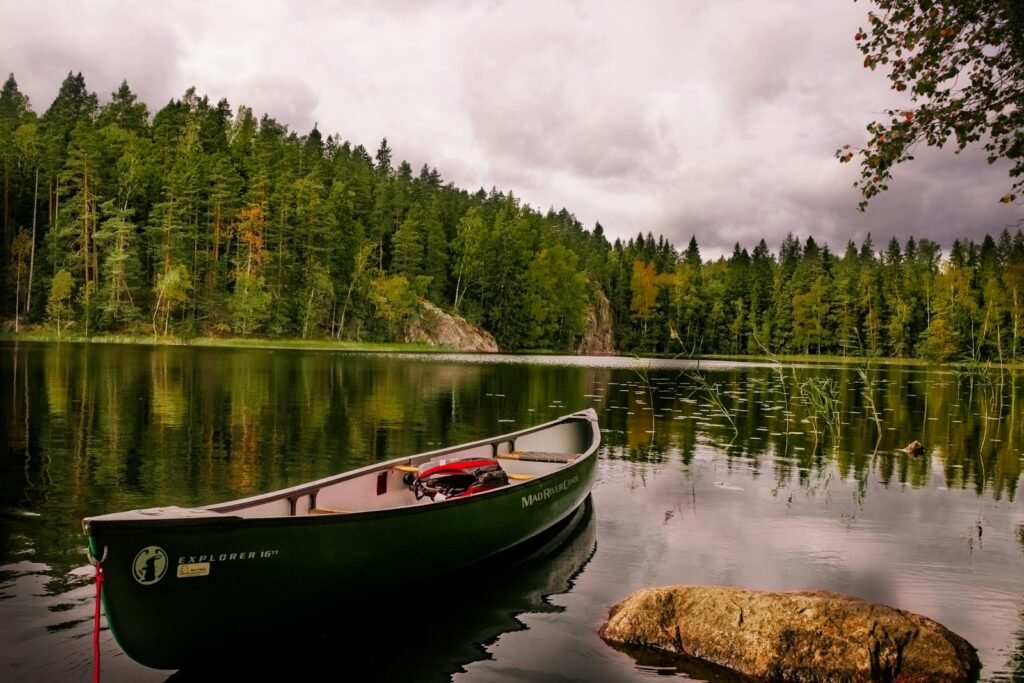Ever wondered about the dimensions of a canoe, that sleek vessel that cuts through water with ease? Perhaps you’re an outdoor enthusiast planning your next big adventure or a newbie considering buying your first canoe. Either way, knowing the length and width of canoes is crucial.
The average canoe measures around 13 to 17 feet in length and approximately three feet in width. However, these dimensions can vary based on design and purpose.
Stick around as we paddle further into this topic. We’ll dive into why these measurements matter, how they affect performance, and what it means for you as a paddler. So grab your oar – let’s set sail on this informational journey!

What Determines the Dimensions of a Canoe?
The dimensions of a canoe are primarily determined by its intended use, design requirements, and user specifications.
Whether it’s for recreational paddling, competition racing, or wilderness tripping, each purpose influences the size and shape of this versatile watercraft.
Intended Use
Canoe dimensions vary significantly based on their intended use. Recreational canoes tend to be wider and shorter for stability and maneuverability.
Racing canoes are longer and narrower to maximize speed. Fishing canoes may have additional width for stability while casting lines or reeling in catches.
Design Requirements
In addition to usage considerations, the design requirements also play an essential role in determining canoe dimensions.
Design factors include hull shape (flat-bottomed vs rounded), rocker (the curve from bow to stern), length-to-width ratio, depth, and materials used.
User Specifications
User specifications such as weight capacity, seating arrangement, storage needs also influence the size of a canoe. For instance, tandem canoes designed for two paddlers will typically be longer than solo canes.
So when you’re considering what determines the dimensions of a canoe – remember that it’s not just about aesthetics but rather functionality meeting specific needs.
The Interplay between Size & Performance
Let’s examine how these factors contribute to performance on water. A longer canoe tracks better (stays straight) but is less maneuverable which makes them suitable for long-distance touring or racing.
Shorter canoes offer more agility making them ideal for navigating narrow streams or rivers with tight turns.
Similarly wide boats provide more stability which is great if you’re planning on fishing or bird-watching where sudden movements might occur often; however they are slower due to increased drag in water compared with narrow canoes.
Variations in Size: Exploring Different Types of Canoes
The world of canoes is vast and varied, with a multitude of sizes available to cater to different needs. The size of the canoe plays a crucial role in determining its speed, stability, carrying capacity, and maneuverability.
Here’s an insight into how variation in size influences the functionality and utility of different types of canoes.
Let’s dig deeper into the specifics now.
Small Sized Canoes
Small canoes typically range from 10 to 13 feet in length. They are lightweight, easy to handle, and ideal for solo paddlers or those who prefer calm waters like small lakes or streams.
However, due to their compact size, they offer limited storage space and may not be suitable for long journeys or rough water conditions.
Medium Sized Canoes
Medium-sized canoes fall within the range of 14 to 17 feet. These are versatile boats that strike a balance between speed, stability, and storage capacity.
They’re perfect for recreational use by families or groups on larger bodies of water such as big lakes or rivers.
Large Sized Canoes
Large canoes extend beyond 18 feet up until about 20 feet or more. Known for their high carrying capacity and excellent stability even in turbulent waters, these are ideal for multi-day trips involving heavy gear loads.
Their increased length also aids in maintaining higher speeds over long distances but could make them harder to maneuver especially around tight corners.
The following aspects may help you choose your perfect fit:
- Your Purpose: If you plan on casual paddling across calm waters – opt for smaller ones; medium-sized ones if you’re looking at family outings with moderate load; large ones if you aim at extensive trips with substantial gear.
- Number of Paddlers: Small canoes are perfect for solo paddlers while medium and large ones cater to multiple paddlers.
- Water Type: For calm, narrow streams – small or medium-sized canoes work well. For big lakes or rivers with potential turbulent conditions, larger ones would be a safer bet.
The Role of Length and Width in a Canoe’s Performance
The performance of your canoe is heavily influenced by its length and width. These factors determine how the vessel behaves on water, affecting speed, stability, maneuverability, and capacity.
To get a better understanding of this interplay, let’s break down the impact each dimension has on your canoeing experience.
Impact of Canoe Length
Longer canoes are generally faster than their shorter counterparts. The reason behind this lies in physics – long vessels have a greater hull speed due to an increased waterline length. This makes them ideal for open water where speed is paramount.
However, longer canoes may be harder to steer and require more effort to paddle over short distances or during tight turns.
They’re also less portable compared to shorter canoes due to their heavier weight and larger size.
Influence of Canoe Width
On the other hand, the width (or beam) of a canoe impacts its stability and capacity. A wider canoe offers more lateral stability which reduces the risk of capsizing – making it suitable for beginners or those who plan on carrying heavy loads.
But there’s a trade-off: wider canoes tend to be slower because they create more drag as they move through water.
They may also be harder to paddle solo since you’ll need to reach further out from the centerline.
So when choosing a canoe based on dimensions:
- If speed is crucial – opt for longer models.
- If stability matters most – go with wider options.
How to Choose the Right Canoe Based on Its Size?
When it comes to selecting a canoe, size matters significantly. A suitable-sized canoe not only enhances your paddling experience but also ensures safety during your water adventures. Let’s dig deeper into how you can make an informed choice.
The Length of the Canoe
The length of a canoe plays a crucial role in its performance. Longer canoes are typically faster and have more storage space, making them ideal for long-distance trips or family outings.
However, they may be harder to maneuver compared to shorter ones. Shorter canoes, on the other hand, offer greater control and agility which is perfect for solo trips or fishing excursions.
The Width (Beam) of the Canoe
The width or beam of a canoe impacts stability and speed. Wider canoes tend to be more stable and provide ample room for gear but at the cost of speed due to increased water resistance. Narrower designs are usually faster and more efficient but might feel tippy for inexperienced paddlers.
The Depth of the Canoe
The depth refers to the distance from the bottom center point (keel) up to top edge (gunwale).
Deeper canoes offer better protection against splashing water and accommodate more cargo but might catch wind easily affecting its handling especially in windy conditions.
Here are some aspects that may help you choose:
- Usage: Identify what you’ll primarily use your canoe for – touring, fishing, whitewater rafting etc.
- Paddler’s Skill Level: Beginners should opt for wider and shorter models while experienced paddlers could go with longer versions.
- Cargo Capacity: If carrying heavy loads is essential, consider longer and deeper models.
- Number of Paddlers: Solo paddlers might prefer a shorter canoe while multiple paddlers would need a longer one.
Impact of Materials on the Size and Weight of Canoes
The materials used in constructing a canoe play a significant role in determining its size, weight, and overall performance.
The choice of material can affect not only the canoe’s durability but also its maneuverability and speed. Let’s dig deeper into how different materials impact these aspects.
The Role of Wood
Traditionally, wood has been a popular choice for building canoes due to its natural buoyancy and aesthetic appeal.
A wooden canoe is generally heavier than those made from other materials, which may make it more stable on water but less easy to transport.
Fiberglass and Its Effects
Fiberglass is another common material used in canoe construction. It offers an excellent balance between weight and strength.
Canoes made from fiberglass are lightweight yet durable, making them easier to handle both on and off water.
Influence of Aluminum
Aluminum is known for its strength-to-weight ratio – it’s light enough for easy portability yet tough enough to withstand rough waters or rocky shores.
However, aluminum canoes tend to be larger because this material isn’t as flexible as others when it comes to molding into smaller sizes.
Plastic Polymers: Polyethylene & Royalex
Polyethylene and Royalex are plastic polymers often used in modern-day canoe manufacturing due their resilience against impacts and abrasions. They allow for lighter, more compact designs without sacrificing durability or stability.
FAQs
What are the typical dimensions of a canoe?
The length of canoes greatly varies, but they typically fall within the range of 10 to 20 feet. The width or beam usually measures between 32 and 38 inches.
How does the size vary for different types of canoes?
Different types of canoes have different sizes. Recreational ones are generally shorter with widths around 36 inches while touring or tripping canoes tend to be longer, about 16-20 feet long and slightly narrower.
What’s the average length and width for racing canoes?
Racing Canoes tend to be long and narrow to increase speed. They often measure anywhere from 18-20 feet in length and approximately just over one foot in width.
Does size affect stability in a canoe?
Yes, it does. A wider canoe tends to provide more stability as it has a larger base area spread across the water surface. On the other hand, longer canoes are faster but may not be as stable as their wider counterparts.
